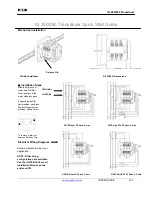
Reference Manual
00809-0100-4825, Rev BB
August 2005
1-3
Rosemount 248
CONSIDERATIONS
General
Electrical temperature sensors such as RTDs and thermocouples produce
low-level signals proportional to their sensed temperature. The Rosemount
248 converts the low-level sensor signal to a standard 4–20 mA dc signal that
is relatively insensitive to lead length and electrical noise. This current signal
is then transmitted to the control room via two wires.
Commissioning
The transmitter can be commissioned before or after installation. It may be
useful to commission it on the bench, before installation, to ensure proper
operation and to become familiar with its functionality. Make sure the
instruments in the loop are installed in accordance with intrinsically safe or
non-incendive field wiring practices before connecting a HART communicator
in an explosive atmosphere. For more information, see “Commissioning” on
page 3-2.
Mechanical
Location
When choosing an installation location and position, take into account the
need for access to the transmitter.
Special Mounting
Special mounting hardware is available for mounting a Rosemount 248 head
mount transmitter to a DIN rail.
Electrical
Proper electrical installation is necessary to prevent errors due to sensor lead
resistance and electrical noise. For best results, shielded cable should be
used in electrically noisy environments. A resistance between 250 and 1100
ohms must be present in the loop for communication with a 375 Field
Communicator.
Make wiring connections through the cable entry in the side of the connection
head. Be sure to provide adequate clearance for cover removal.
Environmental
The transmitter electronics module is permanently sealed within the housing,
resisting moisture and corrosive damage. Verify that the operating
atmosphere of the transmitter is consistent with the appropriate hazardous
locations certifications.
Temperature Effects
The transmitter will operate within specifications for ambient temperatures
between –40 and 185 °F (–40 and 85 °C). Heat from the process is
transferred from the thermowell to the transmitter housing. If the expected
process temperature is near or beyond specification limits, consider the use of
additional thermowell lagging, and extension nipple, or a remote mounting
configuration to isolate the transmitter from the process.
Figure 1-1 provides an example of the relationship between transmitter
housing temperature rise and extension length.
Summary of Contents for 248
Page 2: ......
Page 4: ......
Page 46: ...Reference Manual 00809 0100 4825 Rev BB August 2005 Rosemount 248 4 8 ...
Page 64: ...Reference Manual 00809 0100 4825 Rev BB August 2005 Rosemount 248 A 18 ...
Page 74: ...Reference Manual 00809 0100 4825 Rev BB August 2005 Rosemount 248 B 10 ...
Page 77: ...Reference Manual 00809 0100 4825 Rev BB August 2005 0 1 Rosemount 248 NOTES ...
Page 78: ...Reference Manual 00809 0100 4825 Rev BB August 2005 Rosemount 248 0 2 NOTES ...
Page 79: ...Reference Manual 00809 0100 4825 Rev BB August 2005 0 3 Rosemount 248 NOTES ...










































